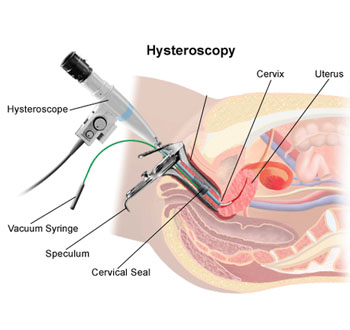Hysteroscopy
Hysteroscopy is a procedure that allows your doctor to look inside your uterus in order to diagnose and treat causes of abnormal bleeding. Hysteroscopy is done using a hysteroscope, a thin, lighted tube that is inserted into the vagina to examine the cervix and inside of the uterus (lining, cavity) & fallopian tube. Operative hysteroscopy can be used to remove polyps, fibroids, and adhesions. Lost Cupper T (CuT), any foreign body.
Diagnostic hysteroscopy?
Diagnostic hysteroscopy is used to diagnose problems of the uterus. Diagnostic hysteroscopy is also used to confirm results of other tests, such as hysterosalpingography (HSG). HSG is an X-ray dye test used to check the uterus and fallopian tubes. Diagnostic hysteroscopy can often be done in an office setting.
Additionally, hysteroscopy can be used with other procedures, such as laparoscopy, or before procedures such as dilation and curettage (D&C). In laparoscopy, your doctor will insert an endoscope (a slender tube fitted with a fiber-optic camera) into your abdomen to view the outside of your uterus, ovaries, and fallopian tubes. The endoscope is inserted through an incision made through or below your navel.
Operative hysteroscopy?
Operative hysteroscopy is used to correct an abnormal, for e.g., septal uterus or polyp. If an abnormal condition was detected during the diagnostic hysteroscopy, an operative hysteroscopy can be performed at the same time, avoiding the need for a second surgery. During operative hysteroscopy, small instruments used to correct the condition are inserted through the hysteroscope.
- Polyps and fibroids: Hysteroscopy is used to remove these non-cancerous growths found in the uterus.
- Adhesions: Also known as Asherman’s Syndrome, uterine adhesions are bands of scar tissue that can form in the uterus and may lead to changes in menstrual flow as well as infertility. Hysteroscopy can help your doctor locate and remove the adhesions.
- Septums: Hysteroscopy can help determine whether you have a uterine septum, a malformation (defect) of the uterus that is present from birth.
- Abnormal bleeding: Hysteroscopy can help identify the cause of heavy or lengthy menstrual flow, as well as bleeding between periods or after menopause. Endometrial ablation is one procedure in which the hysteroscope, along with other instruments, is used to destroy the uterine lining in order to treat some causes of heavy bleeding.


